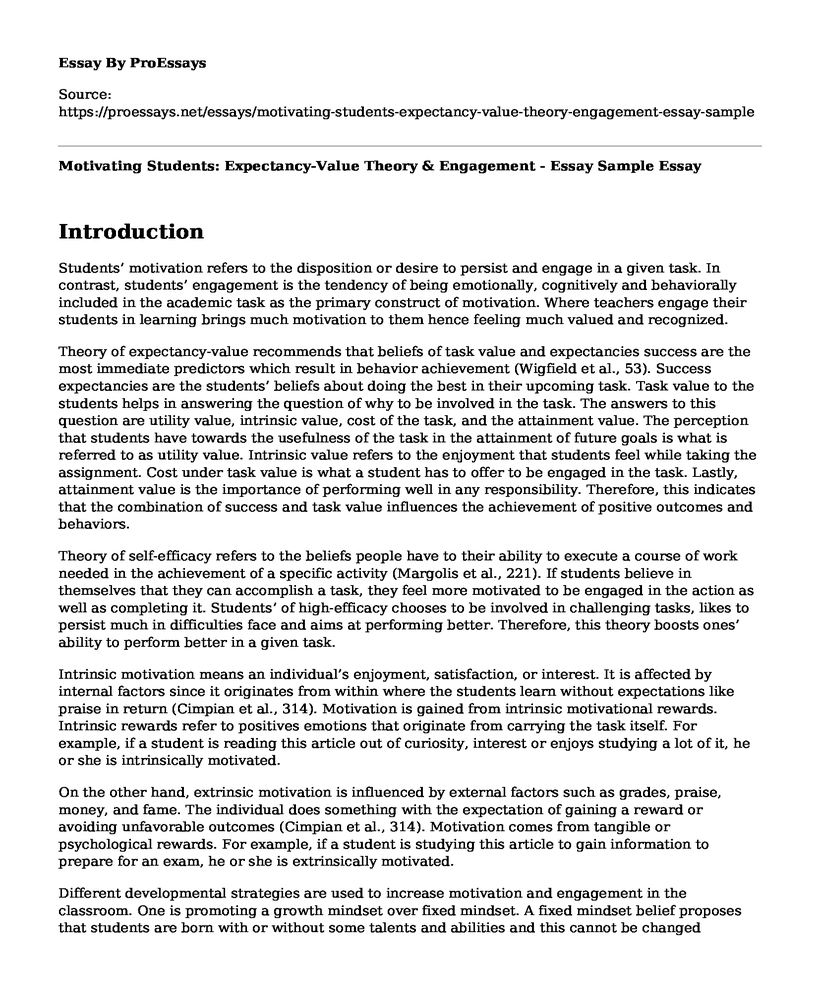Introduction
Students’ motivation refers to the disposition or desire to persist and engage in a given task. In contrast, students’ engagement is the tendency of being emotionally, cognitively and behaviorally included in the academic task as the primary construct of motivation. Where teachers engage their students in learning brings much motivation to them hence feeling much valued and recognized.
Theory of expectancy-value recommends that beliefs of task value and expectancies success are the most immediate predictors which result in behavior achievement (Wigfield et al., 53). Success expectancies are the students’ beliefs about doing the best in their upcoming task. Task value to the students helps in answering the question of why to be involved in the task. The answers to this question are utility value, intrinsic value, cost of the task, and the attainment value. The perception that students have towards the usefulness of the task in the attainment of future goals is what is referred to as utility value. Intrinsic value refers to the enjoyment that students feel while taking the assignment. Cost under task value is what a student has to offer to be engaged in the task. Lastly, attainment value is the importance of performing well in any responsibility. Therefore, this indicates that the combination of success and task value influences the achievement of positive outcomes and behaviors.
Theory of self-efficacy refers to the beliefs people have to their ability to execute a course of work needed in the achievement of a specific activity (Margolis et al., 221). If students believe in themselves that they can accomplish a task, they feel more motivated to be engaged in the action as well as completing it. Students’ of high-efficacy chooses to be involved in challenging tasks, likes to persist much in difficulties face and aims at performing better. Therefore, this theory boosts ones’ ability to perform better in a given task.
Intrinsic motivation means an individual’s enjoyment, satisfaction, or interest. It is affected by internal factors since it originates from within where the students learn without expectations like praise in return (Cimpian et al., 314). Motivation is gained from intrinsic motivational rewards. Intrinsic rewards refer to positives emotions that originate from carrying the task itself. For example, if a student is reading this article out of curiosity, interest or enjoys studying a lot of it, he or she is intrinsically motivated.
On the other hand, extrinsic motivation is influenced by external factors such as grades, praise, money, and fame. The individual does something with the expectation of gaining a reward or avoiding unfavorable outcomes (Cimpian et al., 314). Motivation comes from tangible or psychological rewards. For example, if a student is studying this article to gain information to prepare for an exam, he or she is extrinsically motivated.
Different developmental strategies are used to increase motivation and engagement in the classroom. One is promoting a growth mindset over fixed mindset. A fixed mindset belief proposes that students are born with or without some talents and abilities and this cannot be changed (Cimpian et al., 315). Fixed mindset students attest themselves and continuously run from challenges since they dislike to be seen struggling. Growth mindset students believe that talents and abilities can be improved or cultivated by working hard. They enjoy struggles and challenges as part of growth. Growth mindset students are highly motivated.
Developing a respectful and meaningful relationship with learners where K-8 teachers need to engage in motivating all students and must know each student from personal level. They need to know their hobbies and interest, family situations, and what excites them (Cimpian et al., 315). So, each student will require different motivational strategies, and teachers should know them to determine which ones to use.
Growing a community of students in a class where learners like classroom surroundings, which is safe, where they are eager to take struggles and risks (Cimpian et al., 316). To accomplish this goal, K-8 teachers and students have to work together on the same collective goal. Learners should be anxious to work with and assist other learners in the class. Struggles must be encouraged and acceptable as part of the learning procedure. Therefore working together motivates students to learn hence leading ton success.
Teachers’ effectiveness encourages students as they are motivated by teachers’ positive reinforcement and approval (Cimpian et al., 316). This makes them enthusiastic concerning learning as they feel much valued and recognized. Effectiveness of teachers also stimulates the students’ creativity. Where teachers encourage debates among the students and use visual aids in enriching subject matter motivates students to be creative. For example, the use of posters to decorate the classroom improves students’ creativity as they think of coming up with the best signs for their class decoration.
Work Cited
Wigfield, Allan, and Jenna Cambria. "Expectancy-value theory: Retrospective and prospective." Advances in motivation and achievement 16.part A (2010): 35-70. https://www.emerald.com/insight/content/doi/10.1108/S0749-7423(2010)000016A005/full/html
Margolis, Howard, and Patrick P. McCabe. "Improving self-efficacy and motivation: What to do, what to say." Intervention in school and clinic 41.4 (2006): 218-227. https://journals.sagepub.com/doi/abs/10.1177/10534512060410040401
Cimpian, Andrei, et al. "Subtle linguistic cues affect children's motivation." Psychological Science 18.4 (2007): 314-316. https://journals.sagepub.com/doi/full/10.1111/j.1467-9280.2007.01896.x
Cite this page
Motivating Students: Expectancy-Value Theory & Engagement - Essay Sample. (2023, Aug 22). Retrieved from https://proessays.net/essays/motivating-students-expectancy-value-theory-engagement-essay-sample
If you are the original author of this essay and no longer wish to have it published on the ProEssays website, please click below to request its removal:
- Application Letter Example: An Accountant Position in Flour Corporation
- Research Paper on Decreasing Depression and Suicide through Extracurricular Activities
- Persuasive Essay on Academic Achievement
- Why I Am Interested in Being a Physician Assistant Essay
- Intercultural Analysis of 'Always Running'
- Paper Example on IQ Score Variance in Student: Case Study
- Annotated Bibliography Sample on Mobile Phones and Social Interaction: A Comparative Study of University Students







